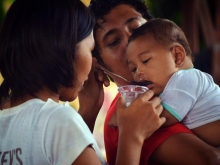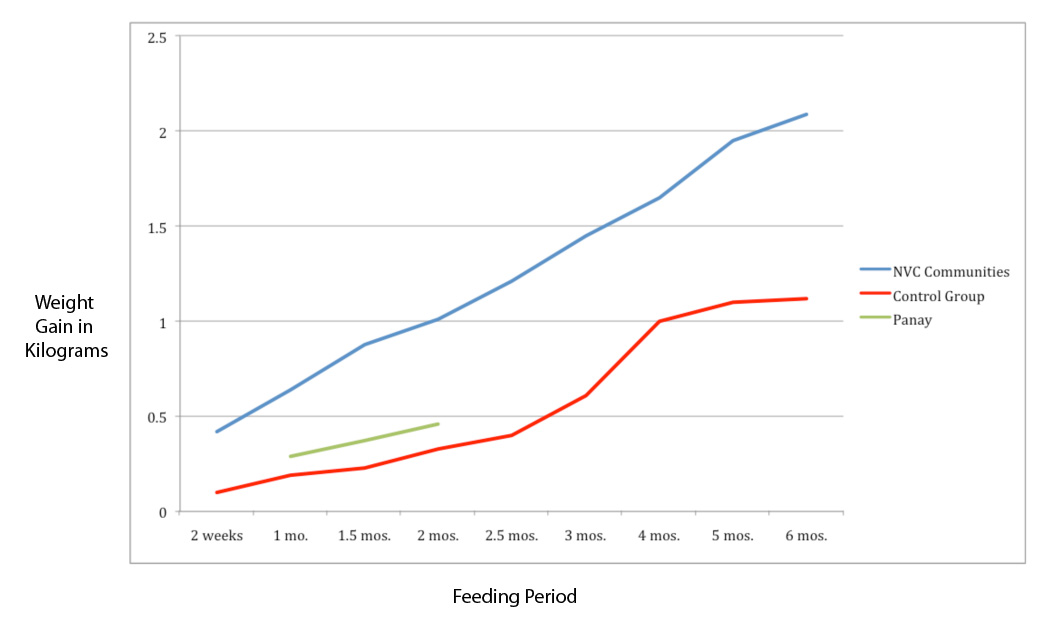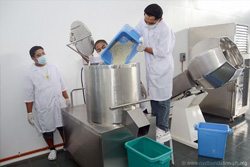Beneficiaries

Nutritional deficits in babies from 6-18 months can cause stunting, poor school performance, reduced productivity and social development that will continue throughout their lives.
NVC targets undernourished infants, toddlers and young children during the vulnerable period of early growth. Through its 6-month nutrition program called Start Right, Live Bright, NVC provides beneficiary children with the ingredients necessary for optimal growth, the development of psychomotor and cognitive functions, and boosting immunity against infectious diseases.
NVC has also brought its nutrition program to areas hard-hit by supertyphoon Haiyan; the United Nations estimates that as many as 1.5 million children are in danger of malnutrition as a result of this disaster. The children of fishermen beneficiaries under The Peter Project are also given Mingo.
Mingo is also used as emergency food for evacuees and victims of disasters, calamities, and conflict all over the Philippines. NVC also works with other groups to provide Mingo in bulk for their own relief and emergency efforts.
Start Right, Live Bright
 NVC designed and implemented a 6-month feeding program — Start Right, Live Bright — to provide complementary food to children aged 6–30 months in deprived communities and Peter Project fishing communities.
NVC designed and implemented a 6-month feeding program — Start Right, Live Bright — to provide complementary food to children aged 6–30 months in deprived communities and Peter Project fishing communities.
Program recipients in each community are carefully screened to ensure that the babies come from families in need, and that breastfeeding is practiced by the mothers whenever applicable.
For 6 months, each child receives a daily 20-gram sachet of Mingo to boost his or her nutritional intake for the day. As opposed to other feeding programs that require children to come to a center, mothers feed their children Mingo at home, making it easier to comply with the daily feeding requirement.
Rationale for Early Childhood Feeding
According to the World Health Organization Report for the Global Consultation on Complementary Feeding, from six months onwards, breast milk alone is no longer sufficient to meet the needs of the growing child. Nutritional deficits in babies from 6-18 months can cause stunting, poor school performance, reduced productivity and social development that will continue throughout their lives. Deficits acquired at this age are difficult to correct later in childhood.
Time magazine also reported on February 21, 2011 that the quality of nutrition contributed to higher IQs in children below age 3. After this age, however, intelligence scores could not be changed with improved diets. This was based on a study of British children.
Most of the feeding programs undertaken by both government and non-government organizations focus on children aged of 2 ½ years and older, when they are already in day care or elementary school. NVC Foundation fills a gap by focusing on the nutritional support requirements of infants and toddlers.
Monitoring Results
The nutrition program was first implemented from September 2011-March 2012 in 14 sites across Negros Occidental, with 729 beneficiary infant and children. Regular monitoring of beneficiaries showed a marked difference in weight increase between babies who were part of the program and those who were not. The NVC protocol involved home-based feeding and maternal education, as opposed to a similar program in Panay using the same formula complementary food that used a center-based feeding protocol. Although the implementation of home feeding has more logistical considerations, its results are significantly better than that of the center-based feeding program–presumably because mothers may not have been able, for various reasons, to bring their children to the center daily.
Mothers saw changes not only in the physical condition of their children. Some mothers saw a marked difference in intellectual and social behavior between the babies fed the complementary food vs their older siblings when they were of the same age.

Results of NVC Nutrition Program vs. Panay Feeding Program and a Control Group. Click on the image to view a larger version.
Nutritional Content
Mingo is made up of basic ingredients: moringga (known in Filipino as malunggay), rice, and mung beans (monggo). It is patterned after the formula created by the Food Nutrition and Research Institute of the Department of Science and Technology. Cocoa has also been added to a chocolate-flavored variant.
| UN Recommendation | NVC Blend |
| per 100gm dry product | |
| 400 kcal | 400.05 kcal |
| 14% protein | 14.37 % protein |
| 6% fat | 6.04% fat |
| *Laboratory results from SGS Phil., Inc. | |
The Special Committee on Nutrition Working Group of the United Nations in 2006 has determined product specifications for blended food particularly intended for older infants and young children. The comparative chart, right, shows how Mingo compares with the UN’s base requirements.
Mingo also contains Vitamins A, C, B1, and B6, as well as Potassium, Iron, Calcium and Zinc.
Production Facility
 Mingo is manufactured in an NVC-managed production plant in Bacolod City, Philippines. We use equipment provided by the Department of Science and Technology and other donors. Whenever you donate or order Mingo, you’re also providing its manufacturers with a source of livelihood aside from helping to feed children.
Mingo is manufactured in an NVC-managed production plant in Bacolod City, Philippines. We use equipment provided by the Department of Science and Technology and other donors. Whenever you donate or order Mingo, you’re also providing its manufacturers with a source of livelihood aside from helping to feed children.


